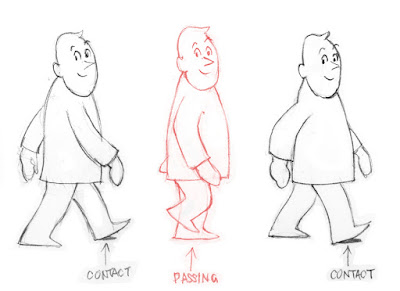Time for another episode of...
The Old Man Walks In and Stops
This is a short scene where the steamer trunk is sitting on the sidewalk; the Old Man walks up to it, stops, and places his hand on the top.
I have previously animated the Old Man twice in a walk. In the first, the walk is lopsided and under constant strain as he is dragging his trunk along behind him. In the second, he quickly walks off screen. This time I will show him full length, including his feet, so I am establishing a style for him that is to be his normal walk.
First I determined that it should take him 4 steps to get him from the starting pose to the end. Then, thinking that an old man might move slowly, I decided each step should be 16 frames, a little longer than the average 12 frames per step. Blocking that in, with only the contact and passing positions drawn, I did this first pencil test with 8 exposures per drawing; thus, with only 1/4 of the drawings done, I can nevertheless evaluate the rhythm of his steps, since each step is already at 16 frames; the timing is the same as the final animation will be.
This shows me that the general timing works and also that the mass and perspective are consistent and convincing.
The arm and hand movement here is experimental and, as you will see, required some more thought, but at the time of this test I was happy with it.
Contact and Passing Positions
This looks like a good time to review what is meant by Contact and Passing positions in a walk.
If you want to do a character walking, where do you start? Well, you start with an extreme, a drawing that illustrates the instant when an outstretched foot touches down to the ground: the contact position. (There are animators who prefer to start with the passing position, which is the point halfway between the left and right contacts.) The passing position tends to be undramatic as a silhouette, with one leg passing in front of the other and with both arms more-or-less even with the body. The passing position is the breakdown between the extremes of the left and right contact positions.
1
Not a Standard Walk Cycle
Note that this walk is not a repeatable cycle since the Old Man is turning as he walks and the drawings could not be properly looped. A good working method here might be to first do an actual repeatable cycle as a reference, then extrapolate from those drawings as the camera or the character turns in perspective. I did this once with a running character where the effect was that the "camera" swooped up and over the runner until we were looking straight down on him. It worked, but in this case, with just a small turn involved from 3/4 front to 3/4 rear, I felt I could do it without that preliminary cycle.
More Drawings
Next I filled in one drawing between each existing pair. I now make a new pencil test, exposing each drawing for 4 frames, which maintains the same timing as before. Here is a section of the pencil test exposure sheet for both the first and second tests. (With my pencil test software, Toki Line Test, I can put all the versions of the pencil test into one file, with each version on a new layer. All layers except the one I want to view or to output as a Movie can be turned off. Probably this is possible with other software as well.)
 |
| Here, the A column shows the first test, while the B column shows the second. You can see how the position of drawing 9, for example, begins both times at the same frame. |
All the Drawings
Everything still seems to be working, so I push on and add all the remaining drawings. For the walk, that means one more drawing between each existing pair. (The section at the end of the scene, after he stops and when he places a hand on the trunk, is more complex than this.)
It is time for a third pencil test, and now that all the drawings are in, we shall have a complete idea of the movement, even if some drawings are still quite rough.
Here again is a part of the exposure sheet, with this test represented in column C.
 |
| With all the drawings now present, you can see that each drawing in column C has only 2 exposures and, again, drawing 17 begins on frame 17. The three pencil tests are all the same length. |
Next: Fixing What Is Not Right




No comments:
Post a Comment